[English] 日本語
 Yorodumi
Yorodumi- PDB-7c8w: Structure of sybody MR17 in complex with the SARS-CoV-2 S recepto... -
+ Open data
Open data
- Basic information
Basic information
| Entry | Database: PDB / ID: 7c8w | ||||||||||||
|---|---|---|---|---|---|---|---|---|---|---|---|---|---|
| Title | Structure of sybody MR17 in complex with the SARS-CoV-2 S receptor-binding domain (RBD) | ||||||||||||
 Components Components |
| ||||||||||||
 Keywords Keywords |  PROTEIN BINDING / PROTEIN BINDING /  coronavirus / coronavirus /  Covid-19 / Covid-19 /  nanobody / nanobody /  neutralizing antibody / neutralizing antibody /  receptor binding protein / receptor binding protein /  SARS-CoV-2 / SARS-CoV-2 /  S protein / S protein /  synthetic antibody / VHH. synthetic antibody / VHH. | ||||||||||||
| Function / homology |  Function and homology information Function and homology informationMaturation of spike protein / viral translation / Translation of Structural Proteins / Virion Assembly and Release / host cell surface / host extracellular space / suppression by virus of host tetherin activity / Induction of Cell-Cell Fusion / structural constituent of virion / host cell endoplasmic reticulum-Golgi intermediate compartment membrane ...Maturation of spike protein / viral translation / Translation of Structural Proteins / Virion Assembly and Release / host cell surface / host extracellular space / suppression by virus of host tetherin activity / Induction of Cell-Cell Fusion / structural constituent of virion / host cell endoplasmic reticulum-Golgi intermediate compartment membrane / entry receptor-mediated virion attachment to host cell / receptor-mediated endocytosis of virus by host cell / Attachment and Entry /  membrane fusion / positive regulation of viral entry into host cell / receptor-mediated virion attachment to host cell / membrane fusion / positive regulation of viral entry into host cell / receptor-mediated virion attachment to host cell /  receptor ligand activity / host cell surface receptor binding / fusion of virus membrane with host plasma membrane / fusion of virus membrane with host endosome membrane / receptor ligand activity / host cell surface receptor binding / fusion of virus membrane with host plasma membrane / fusion of virus membrane with host endosome membrane /  viral envelope / symbiont-mediated suppression of host type I interferon-mediated signaling pathway / virion attachment to host cell / SARS-CoV-2 activates/modulates innate and adaptive immune responses / host cell plasma membrane / virion membrane / viral envelope / symbiont-mediated suppression of host type I interferon-mediated signaling pathway / virion attachment to host cell / SARS-CoV-2 activates/modulates innate and adaptive immune responses / host cell plasma membrane / virion membrane /  membrane / identical protein binding / membrane / identical protein binding /  plasma membrane plasma membraneSimilarity search - Function | ||||||||||||
| Biological species | synthetic construct (others)  Severe acute respiratory syndrome coronavirus 2 Severe acute respiratory syndrome coronavirus 2 | ||||||||||||
| Method |  X-RAY DIFFRACTION / X-RAY DIFFRACTION /  SYNCHROTRON / SYNCHROTRON /  MOLECULAR REPLACEMENT / Resolution: 2.77 Å MOLECULAR REPLACEMENT / Resolution: 2.77 Å | ||||||||||||
 Authors Authors | Li, T. / Cai, H. / Yao, H. / Qin, W. / Li, D. | ||||||||||||
| Funding support |  China, 3items China, 3items
| ||||||||||||
 Citation Citation |  Journal: Nat Commun / Year: 2021 Journal: Nat Commun / Year: 2021Title: A synthetic nanobody targeting RBD protects hamsters from SARS-CoV-2 infection. Authors: Tingting Li / Hongmin Cai / Hebang Yao / Bingjie Zhou / Ning Zhang / Martje Fentener van Vlissingen / Thijs Kuiken / Wenyu Han / Corine H GeurtsvanKessel / Yuhuan Gong / Yapei Zhao / Quan ...Authors: Tingting Li / Hongmin Cai / Hebang Yao / Bingjie Zhou / Ning Zhang / Martje Fentener van Vlissingen / Thijs Kuiken / Wenyu Han / Corine H GeurtsvanKessel / Yuhuan Gong / Yapei Zhao / Quan Shen / Wenming Qin / Xiao-Xu Tian / Chao Peng / Yanling Lai / Yanxing Wang / Cedric A J Hutter / Shu-Ming Kuo / Juan Bao / Caixuan Liu / Yifan Wang / Audrey S Richard / Hervé Raoul / Jiaming Lan / Markus A Seeger / Yao Cong / Barry Rockx / Gary Wong / Yuhai Bi / Dimitri Lavillette / Dianfan Li /      Abstract: SARS-CoV-2, the causative agent of COVID-19, features a receptor-binding domain (RBD) for binding to the host cell ACE2 protein. Neutralizing antibodies that block RBD-ACE2 interaction are candidates ...SARS-CoV-2, the causative agent of COVID-19, features a receptor-binding domain (RBD) for binding to the host cell ACE2 protein. Neutralizing antibodies that block RBD-ACE2 interaction are candidates for the development of targeted therapeutics. Llama-derived single-domain antibodies (nanobodies, ~15 kDa) offer advantages in bioavailability, amenability, and production and storage owing to their small sizes and high stability. Here, we report the rapid selection of 99 synthetic nanobodies (sybodies) against RBD by in vitro selection using three libraries. The best sybody, MR3 binds to RBD with high affinity (K = 1.0 nM) and displays high neutralization activity against SARS-CoV-2 pseudoviruses (IC = 0.42 μg mL). Structural, biochemical, and biological characterization suggests a common neutralizing mechanism, in which the RBD-ACE2 interaction is competitively inhibited by sybodies. Various forms of sybodies with improved potency have been generated by structure-based design, biparatopic construction, and divalent engineering. Two divalent forms of MR3 protect hamsters from clinical signs after live virus challenge and a single dose of the Fc-fusion construct of MR3 reduces viral RNA load by 6 Log. Our results pave the way for the development of therapeutic nanobodies against COVID-19 and present a strategy for rapid development of targeted medical interventions during an outbreak. | ||||||||||||
| History |
|
- Structure visualization
Structure visualization
| Structure viewer | Molecule:  Molmil Molmil Jmol/JSmol Jmol/JSmol |
|---|
- Downloads & links
Downloads & links
- Download
Download
| PDBx/mmCIF format |  7c8w.cif.gz 7c8w.cif.gz | 96.3 KB | Display |  PDBx/mmCIF format PDBx/mmCIF format |
|---|---|---|---|---|
| PDB format |  pdb7c8w.ent.gz pdb7c8w.ent.gz | 57.8 KB | Display |  PDB format PDB format |
| PDBx/mmJSON format |  7c8w.json.gz 7c8w.json.gz | Tree view |  PDBx/mmJSON format PDBx/mmJSON format | |
| Others |  Other downloads Other downloads |
-Validation report
| Arichive directory |  https://data.pdbj.org/pub/pdb/validation_reports/c8/7c8w https://data.pdbj.org/pub/pdb/validation_reports/c8/7c8w ftp://data.pdbj.org/pub/pdb/validation_reports/c8/7c8w ftp://data.pdbj.org/pub/pdb/validation_reports/c8/7c8w | HTTPS FTP |
|---|
-Related structure data
| Related structure data | 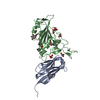 7c8vC 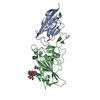 7canC 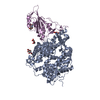 6m0jS S: Starting model for refinement C: citing same article ( |
|---|---|
| Similar structure data |
- Links
Links
- Assembly
Assembly
| Deposited unit | 
| ||||||||||||
|---|---|---|---|---|---|---|---|---|---|---|---|---|---|
| 1 |
| ||||||||||||
| Unit cell |
|
- Components
Components
| #1: Antibody | Mass: 13433.839 Da / Num. of mol.: 1 Source method: isolated from a genetically manipulated source Source: (gene. exp.) synthetic construct (others) / Production host:   Escherichia coli BL21(DE3) (bacteria) Escherichia coli BL21(DE3) (bacteria) |
|---|---|
| #2: Protein | Mass: 23747.643 Da / Num. of mol.: 1 / Fragment: Receptor binding domain Source method: isolated from a genetically manipulated source Source: (gene. exp.)   Severe acute respiratory syndrome coronavirus 2 Severe acute respiratory syndrome coronavirus 2Gene: S, 2 / Cell line (production host): Hi5 / Production host:   Trichoplusia ni (cabbage looper) / References: UniProt: P0DTC2 Trichoplusia ni (cabbage looper) / References: UniProt: P0DTC2 |
| #3: Polysaccharide | alpha-L-fucopyranose-(1-3)-[2-acetamido-2-deoxy-beta-D-glucopyranose-(1-4)][alpha-L-fucopyranose-(1- ...alpha-L-fucopyranose-(1-3)-[2-acetamido-2-deoxy-beta-D-glucopyranose-(1-4)][alpha-L-fucopyranose-(1-6)]2-acetamido-2-deoxy-beta-D-glucopyranose / Mass: 716.682 Da / Num. of mol.: 1 / Mass: 716.682 Da / Num. of mol.: 1Source method: isolated from a genetically manipulated source |
| #4: Chemical | ChemComp-GOL /  Glycerol Glycerol |
| Has ligand of interest | Y |
-Experimental details
-Experiment
| Experiment | Method:  X-RAY DIFFRACTION / Number of used crystals: 1 X-RAY DIFFRACTION / Number of used crystals: 1 |
|---|
- Sample preparation
Sample preparation
| Crystal | Density Matthews: 3.63 Å3/Da / Density % sol: 66.07 % |
|---|---|
Crystal grow | Temperature: 293 K / Method: vapor diffusion, sitting drop Details: 0.2M magnesium formate dihydrate, 20% w/v polyethylene glycol 3350 |
-Data collection
| Diffraction | Mean temperature: 100 K / Serial crystal experiment: N |
|---|---|
| Diffraction source | Source:  SYNCHROTRON / Site: SYNCHROTRON / Site:  SSRF SSRF  / Beamline: BL19U1 / Wavelength: 0.97853 Å / Beamline: BL19U1 / Wavelength: 0.97853 Å |
| Detector | Type: PSI PILATUS 6M / Detector: PIXEL / Date: May 10, 2020 |
| Radiation | Protocol: SINGLE WAVELENGTH / Monochromatic (M) / Laue (L): M / Scattering type: x-ray |
| Radiation wavelength | Wavelength : 0.97853 Å / Relative weight: 1 : 0.97853 Å / Relative weight: 1 |
| Reflection | Resolution: 2.77→49.71 Å / Num. obs: 13308 / % possible obs: 100 % / Redundancy: 21 % / Biso Wilson estimate: 73.65 Å2 / CC1/2: 0.997 / Rmerge(I) obs: 0.276 / Rpim(I) all: 0.062 / Net I/σ(I): 11.1 |
| Reflection shell | Resolution: 2.77→2.92 Å / Redundancy: 20.8 % / Rmerge(I) obs: 2.222 / Mean I/σ(I) obs: 1.5 / Num. unique obs: 1909 / CC1/2: 0.753 / Rpim(I) all: 0.494 / % possible all: 99.9 |
- Processing
Processing
| Software |
| ||||||||||||||||||||||||||||||||||||||||||||||||||||||||||||||||||||||
|---|---|---|---|---|---|---|---|---|---|---|---|---|---|---|---|---|---|---|---|---|---|---|---|---|---|---|---|---|---|---|---|---|---|---|---|---|---|---|---|---|---|---|---|---|---|---|---|---|---|---|---|---|---|---|---|---|---|---|---|---|---|---|---|---|---|---|---|---|---|---|---|
| Refinement | Method to determine structure : :  MOLECULAR REPLACEMENT MOLECULAR REPLACEMENTStarting model: 6M0J Resolution: 2.77→49.71 Å / SU ML: 0.424 / Cross valid method: FREE R-VALUE / σ(F): 1.34 / Phase error: 28.4731 Stereochemistry target values: GeoStd + Monomer Library + CDL v1.2
| ||||||||||||||||||||||||||||||||||||||||||||||||||||||||||||||||||||||
| Solvent computation | Shrinkage radii: 0.9 Å / VDW probe radii: 1.11 Å / Solvent model: FLAT BULK SOLVENT MODEL | ||||||||||||||||||||||||||||||||||||||||||||||||||||||||||||||||||||||
| Displacement parameters | Biso mean: 73.5 Å2 | ||||||||||||||||||||||||||||||||||||||||||||||||||||||||||||||||||||||
| Refinement step | Cycle: LAST / Resolution: 2.77→49.71 Å
| ||||||||||||||||||||||||||||||||||||||||||||||||||||||||||||||||||||||
| Refine LS restraints |
| ||||||||||||||||||||||||||||||||||||||||||||||||||||||||||||||||||||||
| LS refinement shell |
|
 Movie
Movie Controller
Controller



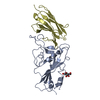

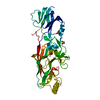
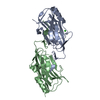
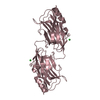



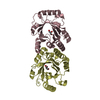

 PDBj
PDBj








